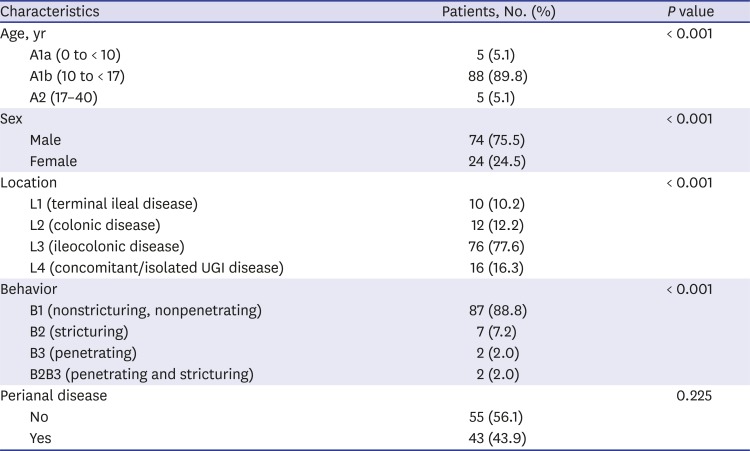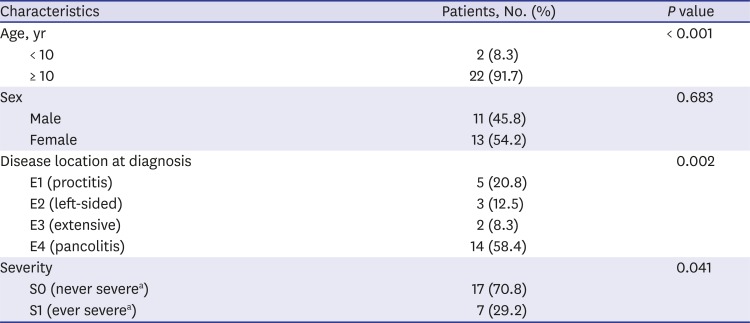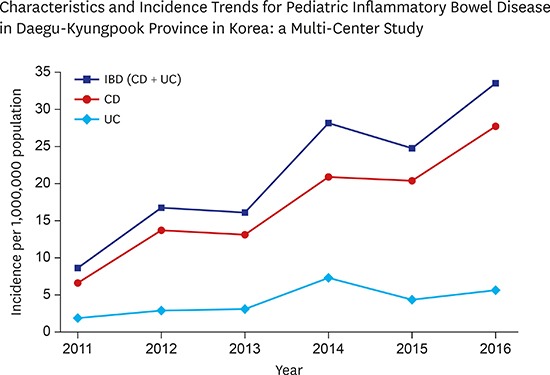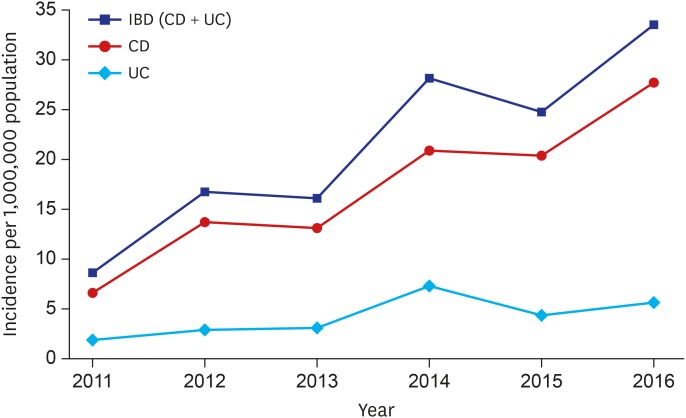1. Yang SK, Yun S, Kim JH, Park JY, Kim HY, Kim YH, et al. Epidemiology of inflammatory bowel disease in the Songpa-Kangdong district, Seoul, Korea, 1986-2005: a KASID study. Inflamm Bowel Dis. 2008; 14(4):542–549. PMID:
17941073.
2. Kim BJ, Song SM, Kim KM, Lee YJ, Rhee KW, Jang JY, et al. Characteristics and trends in the incidence of inflammatory bowel disease in Korean children: a single-center experience. Dig Dis Sci. 2010; 55(7):1989–1995. PMID:
19763825.
3. Benchimol EI, Fortinsky KJ, Gozdyra P, Van den Heuvel M, Van Limbergen J, Griffiths AM. Epidemiology of pediatric inflammatory bowel disease: a systematic review of international trends. Inflamm Bowel Dis. 2011; 17(1):423–439. PMID:
20564651.
4. Levine A, Griffiths A, Markowitz J, Wilson DC, Turner D, Russell RK, et al. Pediatric modification of the Montreal classification for inflammatory bowel disease: the Paris classification. Inflamm Bowel Dis. 2011; 17(6):1314–1321. PMID:
21560194.
5. Song SM, Kim Y, Oh SH, Kim KM. Nutritional status and growth in Korean children with Crohn's disease: a single-center study. Gut Liver. 2014; 8(5):500–507. PMID:
25228974.
6. Malmborg P, Grahnquist L, Lindholm J, Montgomery S, Hildebrand H. Increasing incidence of paediatric inflammatory bowel disease in northern Stockholm County, 2002-2007. J Pediatr Gastroenterol Nutr. 2013; 57(1):29–34. PMID:
23459320.
7. Benchimol EI, Guttmann A, Griffiths AM, Rabeneck L, Mack DR, Brill H, et al. Increasing incidence of paediatric inflammatory bowel disease in Ontario, Canada: evidence from health administrative data. Gut. 2009; 58(11):1490–1497. PMID:
19651626.
8. Malaty HM, Fan X, Opekun AR, Thibodeaux C, Ferry GD. Rising incidence of inflammatory bowel disease among children: a 12-year study. J Pediatr Gastroenterol Nutr. 2010; 50(1):27–31. PMID:
19934770.
9. Benchimol EI, Manuel DG, Guttmann A, Nguyen GC, Mojaverian N, Quach P, et al. Changing age demographics of inflammatory bowel disease in Ontario, Canada: a population-based cohort study of epidemiology trends. Inflamm Bowel Dis. 2014; 20(10):1761–1769. PMID:
25159453.
10. Kang B, Choe YH. Early Biologic Treatment in Pediatric Crohn's Disease: Catching the Therapeutic Window of Opportunity in Early Disease by Treat-to-Target. Pediatr Gastroenterol Hepatol Nutr. 2018; 21(1):1–11. PMID:
29383299.
11. Lee HA, Suk JY, Choi SY, Kim ER, Kim YH, Lee CK, et al. Characteristics of pediatric inflammatory bowel disease in Korea: Comparison with EUROKIDS data. Gut Liver. 2015; 9(6):756. PMID:
25963086.
12. Ng WK, Wong SH, Ng SC. Changing epidemiological trends of inflammatory bowel disease in Asia. Intest Res. 2016; 14(2):111–119. PMID:
27175111.
13. de Bie CI, Paerregaard A, Kolacek S, Ruemmele FM, Koletzko S, Fell JM, et al. Disease phenotype at diagnosis in pediatric Crohn's disease: 5-year analyses of the EUROKIDS Registry. Inflamm Bowel Dis. 2013; 19(2):378–385. PMID:
22573581.
14. Loftus EV Jr, Schoenfeld P, Sandborn WJ. The epidemiology and natural history of Crohn's disease in population-based patient cohorts from North America: a systematic review. Aliment Pharmacol Ther. 2002; 16(1):51–60. PMID:
11856078.
15. Lakatos L, Kiss LS, David G, Pandur T, Erdelyi Z, Mester G, et al. Incidence, disease phenotype at diagnosis, and early disease course in inflammatory bowel diseases in Western Hungary, 2002-2006. Inflamm Bowel Dis. 2011; 17(12):2558–2565. PMID:
22072315.
16. Lowe AM, Roy PO. Epidemiology of Crohn's disease in Quebec, Canada. Inflamm Bowel Dis. 2009; 15(3):429–435. PMID:
18942744.
17. Kugathasan S, Judd RH, Hoffmann RG, Heikenen J, Telega G, Khan F, et al. Epidemiologic and clinical characteristics of children with newly diagnosed inflammatory bowel disease in Wisconsin: a statewide population-based study. J Pediatr. 2003; 143(4):525–531. PMID:
14571234.
18. Lee NY, Park JH. Clinical features and course of Crohn disease in children. Korean J Gastrointest Endosc. 2007; 34(4):193–199.
19. Muller KE, Lakatos PL, Arato A, Kovacs JB, Varkonyi A, Szucs D, et al. Incidence, Paris classification, and follow-up in a nationwide incident cohort of pediatric patients with inflammatory bowel disease. J Pediatr Gastroenterol Nutr. 2013; 57(5):576–582. PMID:
23820399.
20. Hope B, Shahdadpuri R, Dunne C, Broderick AM, Grant T, Hamzawi M, et al. Rapid rise in incidence of Irish paediatric inflammatory bowel disease. Arch Dis Child. 2012; 97(7):590–594. PMID:
22550323.
21. Lee YA, Chun P, Hwang EH, Mun SW, Lee YJ, Park JH. Clinical Features and Extraintestinal Manifestations of Crohn Disease in Children. Pediatr Gastroenterol Hepatol Nutr. 2016; 19(4):236–242. PMID:
28090468.
22. Levine A, de Bie CI, Turner D, Cucchiara S, Sladek M, Murphy MS, et al. Atypical disease phenotypes in pediatric ulcerative colitis: 5-year analyses of the EUROKIDS Registry. Inflamm Bowel Dis. 2013; 19(2):370–377. PMID:
22570259.







 PDF
PDF Citation
Citation Print
Print





 XML Download
XML Download